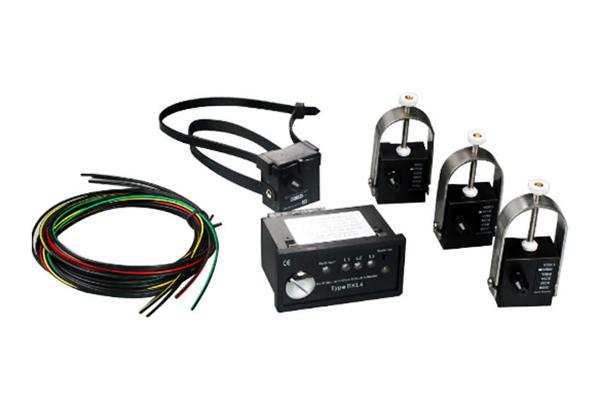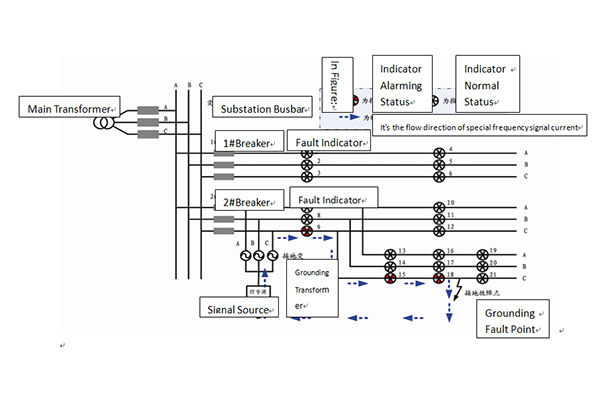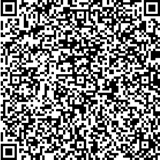When a single phase to the ground fault occurs in the distribution network, a special frequency sinusoidal current is injected through the central point. The current, except part in the central point arc suppression coil, forms a circuit through the fault point and the fault line.
The ground fault indicator and the fault isolating switch are arranged on the distribution circuit, detecting and judging the special frequency current signals of the distribution lines. When the single-phase to the ground fault occurs in the distribution line, the signal source comes into the fault location detecting unit and the special frequency current signals detected by fault isolating switch exceeds the preset threshold, then the fault location detecting unit will alarm, meanwhile, the fault isolation switch will trip to isolate fault, in order to ensure the normal use of electricity along the non-fault line.
When the small current grounded system occurs, the single phase grounded fault, provides no obvious variation characteristic for judging the ground fault. So, in order to make sure the outgoing lines, branches and sections of the grounded fault, it injects the current signal which has obvious characteristic to fault lines as the fault criterion. The current will flow through the fault line, the grounded point and earth and then return the signal source. The fault indicator hanging on the lines could detect the current signal and then flop automatically to indicate the fault outgoing lines and branches. The theory overcame the shortage of low accuracy for the existing products and solved the difficult problem of single grounded fault location. Besides, the fault indicator could judge the characteristic of shorted current to indicate interphase shorted fault through detecting.
The single-phase grounded fault detecting system is made up of four parts: SYEFS type injecting cabinet, SYEFI type fault indicator, SYEFR type communication terminal and SYEFC type distribution power grid fault monitoring center.
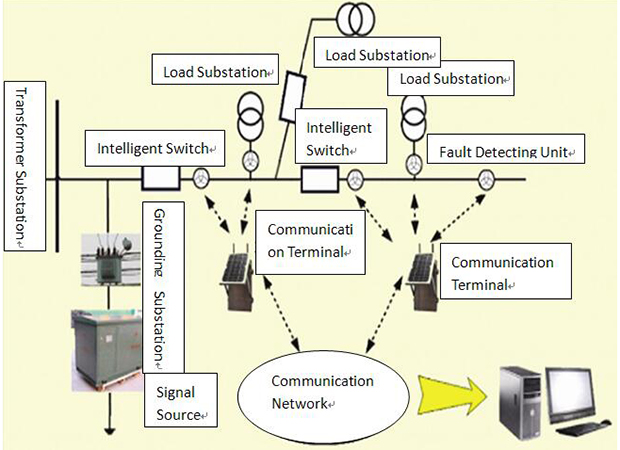
-Working Conditions: The line current is above 5A.
-Environment Temperature: 40℃-70℃
-Detectable Fault Type: Single- phase grounded fault, shorted fault.
-Applicable Lines: Overhead type of bare conductor and overhead type of insulated lines, which could be installed and disassembled with power.
-Applicable Load Current: 1A-600A
-Applicable Cross Section of Conductor: 25mm2-400mm2
-Reset Time: Standard reset time is 10 hours, and it also could be set according to users’ requirements in the factor.
-Accuracy of Fault Indicator: When the transient resistance is lower than 1200Ω, the indicating accuracy≥98%.
-The transmission type of fault information: 433MHz wireless communication.
-Life service: 8 years
-Shell Material: PC (transparent)
-Installation Method: Loading and unloading with power.
-Maintenance Requirements: Maintenance-free.
1. SYEFS type injecting cabinet:
Overview:
When ground fault occurs, the SYEFS signal source injects special current signal to fault line through busbar. The role of special frequency signal source is to inject power, produce a special frequency signal with constant frequency to start the fault detecting unit hanging on the line.
The special frequency signal source is made up of an injection square wave generator, filter inductance, filter capacitor, injection voltage transformer etc. The special frequency signal produced by special frequency signal source has less impact on system.
Type and significance of the product:
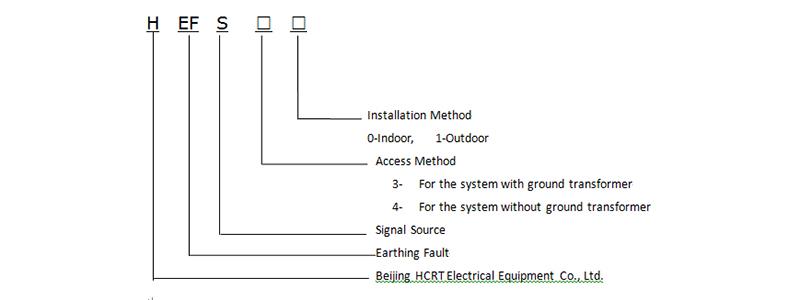
Technical Parameters:
-Primary rated voltage: 6-35kV
-Working voltage: AC380V
-Maximum injection current: ≤2A
-Maximum injection time: ≤120s
-Zero sequence current starting value: 10V-100V
-Accuracy of fault indication: When the transition resistance is less than 1200Ω, the accuracy ≥98%.
-Normal power dissipation: 20W
-Environment Temperature: -40℃-70℃
-Insulation level: Shell withstand voltage of primary terminal is 42kV/1min.
Application:
The ground fault indicator can be installed on overhead lines, power cables or installed in the power equipment, such as box-type substation (BTS), ring main units (RMU), cable branch box, etc., indicating the outgoing lines, branches and sections.
Application environment:
-Working Conditions: -30℃-70℃
-Relative humidity: ≤95%
-Installation: It can be installed indoors and outdoors.
-Access mode: System with or without grounding transformer.
-Maintenance requirement: It is maintenance free.
2. SYEFR type communication terminal:
Features:
-It can receive the fault information from the fault detecting unit.
-It can do decrypted calculation for the signals after demodulation, and then send the fault information to the main station server system.
-It adopts micro-power design, and is installed on the 10kV lines directly, so that it could take power on the lines directly and be powered by solar energy.
-It has high anti-jamming capability, so that it can resist interference of any surrounding electromagnetic field.
Component and Functions:
-Wireless communication terminal collects the fault situation sent from a group or several groups of indicators distributed in the vicinity, and then far send to monitoring server via GPRS. The wireless communication terminal includes the following sections:
-The cabinet used Germany Rittal Enclosure according with the IP-65 level.
-Wireless radio frequency (RF) collecting module: The radio frequency module same with the one within the fault indicator could receive the fault alarm signal from the RF module within the fault indicator.
-GPRS module: The working frequency is 880-915 MHz/925-960 MHz or 110-1785 MHz/1805-1880 MHz.
-The working voltage is 8-30V, with RS232 standard interface, it could communicate with RF module directly, and the maximum output power is 2W (900MHz), 1W (1800MHz).
Type and significance of the product:
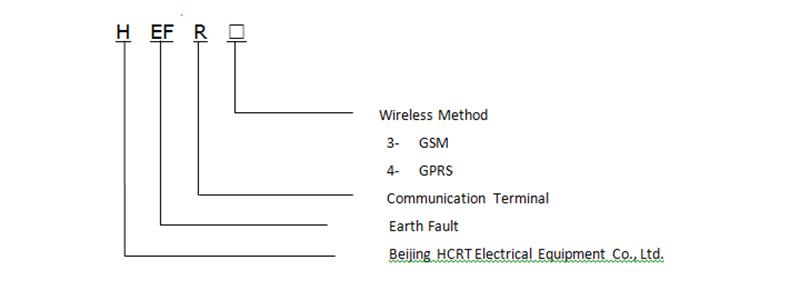
Technical Parameters:
-Environment Temperature: -30℃-70℃
-Relative Humidity: <95%
-Wireless Radio Frequency: 433 MHz
-Wireless Transmit-receive Power: 10mW
-Wireless Communication Distance: <50M
-Wireless Relay Products Life: 10 years
Application environment:
-Working Conditions: -30℃-70℃
- Relative humidity: ≤95%

